Step-by-Step Assembly Guide
If you’re new to building amps, here’s a step-by-step guide to assembling a PIMETA amplifier. If you’re an old hand, you probably won’t find much enlightenment here; you can skip to the next section.
You’ll probably want to have the schematic handy while building the amp.
1. Add the resistors
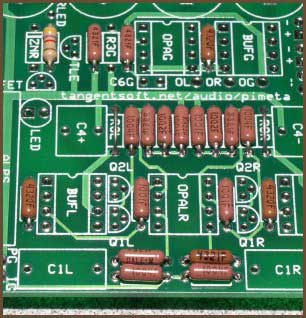
|
As a general rule, you should install the shortest components first, and on the PIMETA board that’s the resistors. If you’re going to socket the resistors, you can still do this step first.
Notice that I’ve used high-spec Vishay-Dale RN55 series resistors for everything but RLED. RLED can be any old junk resistor, but all the other resistors are in or associated with the signal path, so they benefit from higher-quality parts.
The picture doesn’t show it, but if you are going to use the LED cutoff feature of the board (ZNR/CRD) you can also populate those positions now.
2. Add the TO-92 parts
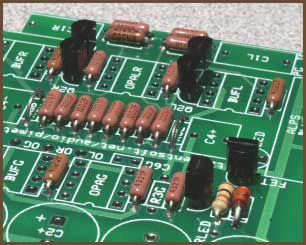
|
This is the TLE2426 and the cascode JFETs. Both of these are optional on the PIMETA.
The PIMETA board is designed with single-voltage supplies in mind, and in this case, you need the TLE2426. However, you can instead use a true dual-voltage power supply, allowing you to leave out the TLE2426. V+ and V- from the power supply go to the outer + and - pad pair, and GND from the power supply goes to the OUT pin of the TLE2426 position.
As for the cascode, if you want to try it but want to hear what the amp sounds like without the cascode, you can pass over this step for now. You can always add the cascode later. However, you may find it easier to add R10 up front, since it’s mildly tricky to add the resistor later if you add sockets for the buffer and op-amp chips, since the sockets are taller than the resistors. It’s not hard to add the JFETs between sockets.
3. Add the diodes
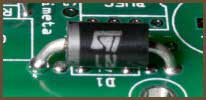
|
To protect your PIMETA from reversed supply voltages, add D1 or a series diode inline with one of the power lines to the board. Be careful to orient the diode properly.
You can add ZNR at this time, if you want the LED cut-off feature.
4. Add the capacitors and sockets
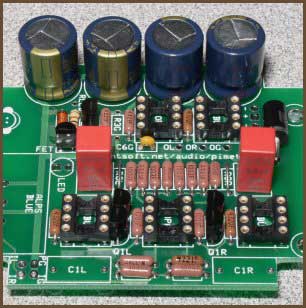
|
Now that all of the small components are placed, you can start placing the large ones.
The electrolytic capacitors (C2/C3) are polarized: the long lead must go into the hole with the square pad. Also, don’t pay too much attention to the picture above when orienting your caps: it shows a v1.0 board, which has a different C2/C3 order than used on the v1.1 board!
The remaining caps (C1, C4 and C6G) are not polarized; they can be placed in the holes in any orientation.
If you add C1, be sure to cut the trace joining the pads, or C1 will be bypassed.
5. Add the pot
Now add the final large component: the volume control.
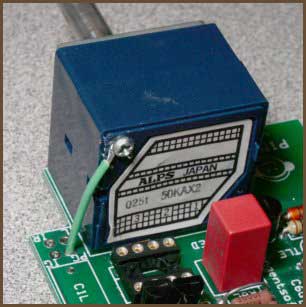
|
You may need to run a wire from the pot’s case to the PG pad as shown in the picture above. If you get humming when you touch the pot’s shaft, try adding the ground strap to see if it goes away. If you get some other kind of noise, especially if it happens when you’re not touching the amp, look elsewhere before grounding your pot. If the pot’s shaft is plastic, the pot’s case probably doesn’t need to be grounded. (The Panasonic EVJ pot is an example of this.)
If you have a pot that doesn’t fit one of the footprints provided on the board, you can run wires from it to the ALPS RK27 pads. Here’s which pad does what:
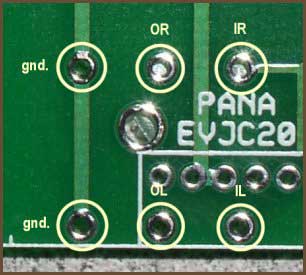
|
The “I” pads go to the input side (i.e. the source), and the “O” pads are the pot’s output (i.e. the wiper). The “gnd” pads, obviously, are for the ground connection.
6. Test the power supply
Run wires from your power supply to the board.
If you have a simple power supply — just a + and a - connection — run them to the outer + and - pads on the board:
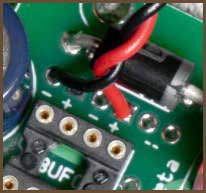
|
If you have two power supplies you want to put in series — typically two 9 V batteries or two AA cell holders — you use both sets of + and - pads:

|
Next, run wires to the power switch pads (- -). (The dashes symbolize two wires, which the switch connects.) If you’re using the ALPS RK097 pot with the built-in power switch, run these wires to the similarly-labeled switch pads near the pot. If you’re using a panel-mounted switch instead, don’t bother to solder the other ends to the switch yet; just strip and tin the free ends.
You may also want to add the LED at this stage. The square pad is for the LED’s positive lead (anode), which is usually the long one. Check your LED’s datasheet to be sure, though!
Next, apply power to the board. If you’re using the RK097 pot with the switch, turn the amp on with the pot; otherwise, jumper the power switch wires together. The LED should light up, and if not, find out why. If the LED lights, check the voltages at all of the DIP-8 chips’ supply pins relative to input ground (IG). If you don’t get approximately half the power supply voltage at each power pin (with the correct polarity) find out why before proceding.
If you’ve installed the current sources already, you should also check that OPALR’s output pins are equal to V-. You can also check that all other pins are at 0 V relative to input ground or very near to it.
When you’re satisfied that the chips are receiving the proper voltages, remove power from the board.
7. Assemble your buffer stacks
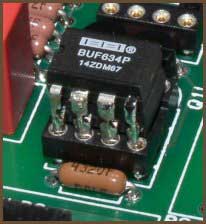
|
If you’re using sockets and are going to stack the buffers, now is a good time to solder up your stacks. We’re just going to solder up the stacks and then set them aside for now, while the board is still outside the case and easy to work with.
I find that the best way to solder up a buffer stack is to bend the leads of one buffer per socket so that it goes into the socket easily, then remove it. Put one of these formed buffers at the bottom of each stack so the whole stack can be inserted into the board easily. The buffers all go in the same orientation. (They are in parallel.)
8. Do the casework and wiring
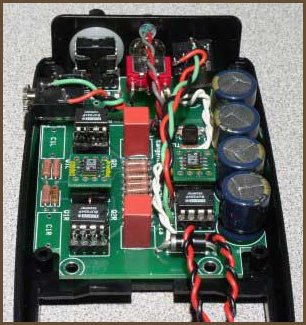
|
Now that the amp board is assembled and the power supply section is known to be working, set it aside and do the casework.
If you haven’t yet read my How to Wire Panel Components article, go read that now.
If you’re using a metal case, you need to be sure you don’t have any conflicts among the panel components. If you’re using a wall power supply and the DC input jack is uninsulated, that means V- gets tied to the case. Now, you may be able to get away with that, but only as long as the pot (via PG) and the I/O jacks are all insulated from the case. Otherwise, you end up tying V- to input ground via the case. If your amp doesn’t fail outright, it will at least misbehave badly. Instead, it’s better to insulate the power input jack from the case somehow; get an inherently insulated jack if you can. Then you can tie input ground to the case via the pot and input jacks without problems. Similarly, the output jack should also be insulated from the case; many audio jacks tie the ground lug to the shell of the jack, which would cause problems in a PIMETA since output ground (OG) must not be tied to input ground or V-.
Install all the components in the panels, and hook them to the amp board with wires:
Power input: There are two + pads and two - pads on the board. You should have populated them a few steps above.
Power switch: There are two pads near the rear edge of the board marked - -. When you tie these pads together, power can flow. If you’re using the ALPS RK097 pot with the built-in power switch, you run wires from these pads to switch pads labelled similarly near the pot. If you’re using a separate power switch, you run the wires to that switch instead. Alternately, you can jumper these two pads and put the switch inline with one of the power leads going to the board.
LED: You can either stick the LED itself on the board (good if you’re putting the amp in a clear case) or run wires from the pads to where the LED mounts on the case. The LED’s polarity matters; be sure you match the LED’s anode to the square pad. The long leg of the LED is usually the anode, but check your datasheet to be sure.
IL, IR, IG: Signal input, if you’re using the ALPS RK27 or Panasonic EVJ pots. Left, right, and ground, respectively.
IL2, IR2, IG2: Same as above, but only for the ALPS RK097 pot.
OL, OR, OG: Signal output.
If you have multiple sets of inputs or outputs, wire only one set for the moment.
9. Add the op-amps and buffers
Now that the amp is almost complete, it’s time to add the parts that will turn it into an amplifier: the op-amp and buffer chips.
Be careful to get the orientation right. The DIP-8 and SO-8 packages used for these chips have 180° rotational symmetry; a chip installed backwards won’t work, and may in fact be fried instantly when you apply power. There is always some marking on the chip that tells you where pin 1 is. There are several alternatives: the edge containing pin 1 may be notched (DIP-8) or beveled (SO-8), or there may be a dot, divot or notch on the upper surface of the package near pin 1. Some chips use only one of these indicators, others use more than one. The PIMETA board, similarly, uses several indicators for pin 1: the silkscreen outlines have a notch mimicking that used by DIP-8 chips, the pad for pin 1 in the DIP-8 footprint is square instead of round like the others, and there is a small dot near the SO-8 footprint’s pin 1.
10. Test the amp
Turn the amp’s power on and do a quick re-check of the voltages at the chip supply pins. The LED should be lit. Turn the amp off and wait until the LED goes completely out. (It will probably take a few seconds.)
Install the remaining chips and turn your amp on. Let it sit for a few seconds and then touch the chips to see if any are getting warm. If they are, you’ve probably got a fault of some kind. If the chips are staying cool, turn your meter to the DC millivolts scale and measure from input ground to each output pin: you should be getting an absolute voltage of less than 20mV. If you’re getting high DC offset levels, you have some debugging to do before you plug headphones into the amp.
Now that we’re reasonably sure the amp is safe to plug headphones into, ensure that the volume knob is turned all the way down, plug the source into the amp, plug some cheap headphones into the amp, and start something playing. Leave the headphones on the table, and slowly turn up the volume. One of several things will happen:
- The volume changes level gradually as you turn the knob.
Put the headphones on and listen critically. Ramp the volume up and
down gently. If it sounds good, turn the volume all the way back down
and repeat the test with your good headphones. If you hear any kind of
noise, read Basic Troubleshooting for Headphone Amplifiers
- The volume shoots up quickly and sounds crackly.
You’ve got some kind of oscillation going on. (Aren’t you
glad the headphones aren’t on your ears now?) Turn the volume
down and find out what the problem is before continuing. The
troubleshooting article linked above may help.
- You don’t hear anything at all. There are two likely causes of this. One is that you’ve got your pot attached to the ALPS RK27 pads and the input jack(s) attached to the IL2, IR2, and IG2 input pads. You must use the regular input pads with this pot position. The alternate input pads are only connected through the ALPS RK097 path. If that’s not the problem, the other likely cause is leaving out R8: it must either be jumpered, or populated with a resistor.
11. Add extra features
Once everything’s working correctly, wire up any secondary input and output jacks and re-test. Finally, add crossfeed, multiple input switching, or any other extra features you want. Re-test after you add each new feature.
When all tests are passing, close the amp up. You’re done! Time to sit back and bask in the glow of a job well done. Grab a beverage and listen to some music.
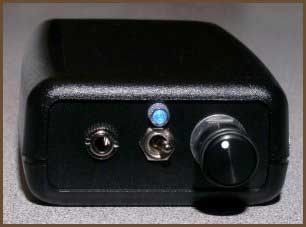
|